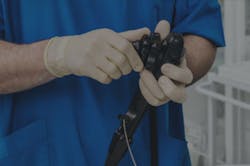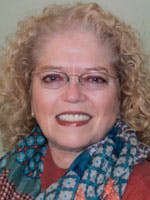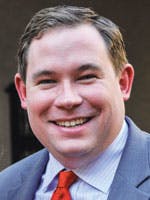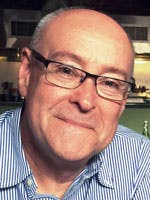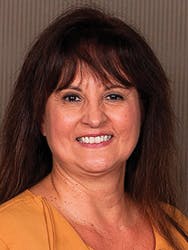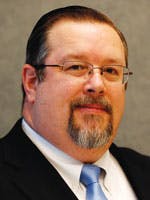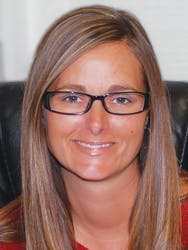Aside from the sterile processing professional, three key groups can have a significant impact on cleaning education and enforcement. They include regulatory and accrediting/certifying bodies, such as the Food and Drug Administration, the Centers for Disease Control and Prevention and The Joint Commission. They also include educational organizations, such as AORN, AAMI, SGNA and IAHCSMM. And finally, they also might include public and private payers, such as the Centers for Medicare and Medicaid Services, and the leading insurance companies.
So how can each group contribute?
REGULATORY BODIES
Donna Swenson, President and CEO, Sterile Processing Quality Services Inc., Stickney, IL
One way that I think we can address this problem is by considering that a dirty medical device that makes it to the point of use is a major problem and a sentinel event. If these are sentinel events, then we will need to investigate how this happened every time that there is a problem. Recognizing that this is a major problem and investigating the causes will start to show where the problems really are.
Many factors can cause a dirty device to make it to the point of use. For example, poor device design, lack of appropriate cleaning equipment, lack of inspection equipment, poor training of the technician, IFUs that are difficult to understand and therefore follow. Determining the root cause is needed if we expect to prevent the problem from occurring again. If this is done, then we might also see common causes from one facility to another which again will provide information on how to fix the problem.
J. Hudson Garrett Jr., Ph.D., MSN, MPH, FNP-BC, PLNC, VA-BC, IP-BC, FACDONA, Global Chief Clinical Officer, Pentax Medical-Hoya Corp.
It is important that all entities within the medical device reprocessing community, including regulatory and accreditation stakeholders, be both aligned and also disseminate evidence based practices related to this important topic. While there is certainly variability in the specific manufacturer’s instructions for use, the essentials elements of infection prevention and control related to medical device hygiene are the same. As an industry, there is always an opportunity to not only standardize clinical education efforts, but also utilize other learning modalities that will more appropriately appeal to the complex needs of healthcare professionals as adult learners.
Richard W. Schule, MBA, FAST, CST, FCS, CRCST, CHMMC, CIS, CHL, AGTS, Director, Clinical Education, STERIS Corp.
Regulatory bodies, such as the FDA, CMS, and the CDC can help to encourage the implementation of quality management systems and cross-reference to the regulations. Businesses, such DNV already do so and The Joint Commission recently began as well. Leaders implementing CMS systems can also work with their customers as well. Collaboration meetings help to drive harmony and offers an opportunity to hear from different stakeholders in the industry.
Robert B. Dybec, R.N., MS, CPSN, CNOR, EMT-B, Nurse Manager, Operating Room Winthrop-University Hospital, Mineola, NY, and Clinical Consultant, Ruhof Corp.
The CDC and FDA have already issued warnings as well as recommendations on the importance of properly cleaning and disinfecting flexible endoscopes. These included educational components that can be used in training and alerting staff on the proper methods of cleaning, disinfection and validation. The CDC has also issued a protocol for healthcare facilities requiring surveillance for bacterial contamination of duodenoscopes after reprocessing, which was a result of recent outbreaks of infection related to these scopes.
These government agencies have the ability to put in place requirements for monitoring aspects of the cleaning process of all scopes. If facilities are mandated to document and submit data to these agencies, that would be a method of enforcement. The Joint Commission is not a regulatory agency but an accrediting body, which holds a lot of power over hospitals. If they focus on the cleaning and disinfecting practices and find inconsistencies or failure to follow current guidelines, hospitals will not receive accreditation. The Joint Commission could use this as a type on enforcement.
Adam Peck, Senior Director of Marketing, CenTrak
Regulatory bodies can contribute to cleaning education and enforcement by encouraging the use of innovative and more efficient monitoring tools, such as Real-Time Location Systems (RTLS) and automated temperature and environmental monitoring solutions. With the potential for wide-spread disease and the risk of infection from medical scopes, it’s crucial for healthcare facilities to have the ability to track and monitor the storage, usage and cleaning lifecycles of these devices.
RTLS enables the accurate tracking of endoscopes throughout each stage of reprocessing and in between key milestones – providing automated documentation and instant alert capabilities if a stage is neglected, or time parameters are missed. Alerts can also be provided to Scope Reprocessing staff immediately after a scope is used and placed into a soiled area to ensure milestones are reached within required time parameters. Automatically identifying which endoscope should be prioritized for use via real-time tracking capabilities can reduce unnecessary and destructive reprocessing.
To ensure proper storage conditions, automated temperature and environmental monitoring solutions can measure ambient temperature and relative humidity 24/7 in scope storage locations. When sensitive assets are exposed to the wrong environmental factors, taking immediate action is critical. Automated environmental monitoring has the ability to provide staff with instant alerts when measurements are sensed above or below set parameters. Improving patient safety is top priority and ensuring regulatory guidance encourages the use of the most effective and efficient methods and technologies for infection control is imperative to this objective.
Jean Sargent, Principal, Sargent Healthcare Strategies
The regulatory bodies have the ability to support SPD with the senior leadership, first by ensuring appropriate staffing, equipment and respect necessary for SPD to support patient care. Then ensuring the manufacturers include the equipment/solution manufactures and providers in testing of the IFU prior to release of the product. Supporting that SPD has the technologies necessary to make them successful, including space, instrument tracking and IFU tracking.
EDUCATIONAL ORGANIZATIONS
Richard W. Schule, MBA, BS, FAST, CST, FCS, CRCST, CHMMC, CIS, CHL, AGTS, Director, Clinical Education, STERIS Corp.
Professional organizations, such as AAMI, AORN, IAHCSMM, SGNA and others can help to create platforms at national, regional, and local education events specific to supporting specialized education. Education needs to be engaging and interactive and not simply an informative lecture. Hands-on workshops and curriculum type programs would help to build growth and commitment.
Over the years, there has been an increased presence at AAMI Sterilization Committee meetings which has provided an improved harmonization between standards and professional guidelines. Professional organizations can also help inform on quality management systems as well as the benefits for deployment.
Robert B. Dybec, RN, MS, CPSN, CNOR, EMT-B, Nurse Manager, Operating Room Winthrop-University Hospital, Mineola, NY, and Clinical Consultant, Ruhof Corp.
ANSI/AAMI, while not specifically educational organizations, provide the comprehensive standards that all other recommended practices are based on. Professional nursing organizations like AORN and SGNA have issued extremely detailed guidelines for the cleaning and reprocessing of flexible scopes. Using evidence-based practice these guidelines are continually updated as needed based on dynamic changes in industry, equipment and technology. By including the need to verify, validate, document, audit and prove staff competencies they can in a sense be enforcing the cleaning practices as hospitals will follow these recommendations or run the risk of losing accreditation.
Brianne Flesher, Flexible Scope Division Manager, Mobile Instrument Service & Repair Inc., Bellefontaine, OH
All of these organizations have gone to great lengths to produce guidance on cleaning, disinfecting/sterilization of endoscopes in an effort to simplify and better define the process. Their contribution to this topic has allowed many SPD professionals increase their understanding of necessary procedures. We support efforts to establish certification standards for staff that reprocess scopes under the auspices of one these trade groups.
J. Hudson Garrett Jr., Ph.D., MSN, MPH, FNP-BC, PLNC, VA-BC, IP-BC, FACDONA, Global Chief Clinical Officer, Pentax Medical-Hoya Corp.
While the collaboration of regulators and manufacturers is essential, equally so is the same relationship with medical associations. The typical focus of associations has historically been specific to their membership demographic (i.e., nursing associations market specifically to nurses, physician organizations market specifically to physicians, etc.), but given the complexity of care delivered in today’s healthcare systems, the use of inter-professional collaboration is important now more than even. Associations can reach and work across disciplines and break down the traditional silos, create cross functional learning opportunities, and measure and validate success.
PAYERS
Donna Swenson, President and CEO, Sterile Processing Quality Services Inc., Stickney, IL
One of the things that needs to be done is to audit the reprocessing activities performed in all areas of the health care facility. CMS requires healthcare facilities to be accredited in order to received Medicare and Medicaid payments. This could be expanded to include showing evidence that quality audits of reprocessing activities are being performed and that management review meetings are being held to address problems that were identified in the audits of reprocessing activities. As required for all quality audits these should be performed by people who have no stake in the results of the audit and not by people who perform the work or are responsible for the work.
Richard W. Schule, MBA, BS, FAST, CST, FCS, CRCST, CHMMC, CIS, CHL, AGTS, Director, Clinical Education, STERIS Corp.
One thought would be to write a dollar value into the reimbursement regulations for organizations to encourage commitment to reinvest into the training of their support staff and not just medical professionals.
Without continued growth and development, low wage earners have to fend for themselves without direction and motivation. The complexity of the devices, systems, processes, quality assurance and quality management systems require commitment to education, training, competency as well as periodic review.
J. Hudson Garrett Jr., Ph.D., MSN, MPH, FNP-BC, PLNC, VA-BC, IP-BC, FACDONA, Global Chief Clinical Officer, Pentax Medical-Hoya Corp.
In healthcare, resources and staffing are a constant challenge in many healthcare systems. Insurers play a vital role in helping to measure and assess quality, but can also help in defining what clinical best practices are in each type of healthcare facility. For example, creating an ideal staffing model to deliver safe and efficient care, would yield savings to both the facility and the insurer, but more importantly improves patient safety. CMS, as the country’s single largest payer, can unique drive practice improvements through reimbursement and legislation through facility licensing and enforcement of compliance with industry accepted, evidence-based practices.
About the Author
Rick Dana Barlow
Senior Editor
Rick Dana Barlow is Senior Editor for Healthcare Purchasing News, an Endeavor Business Media publication. He can be reached at [email protected].
